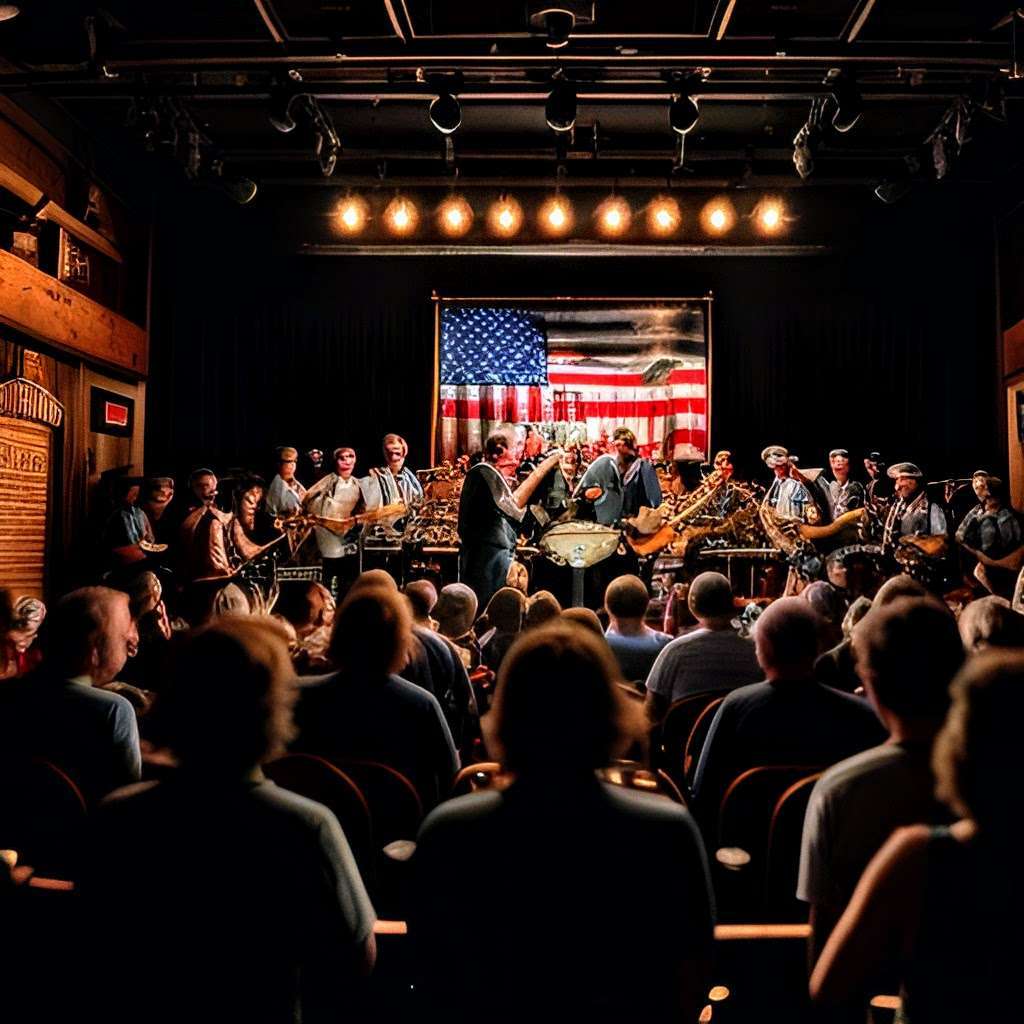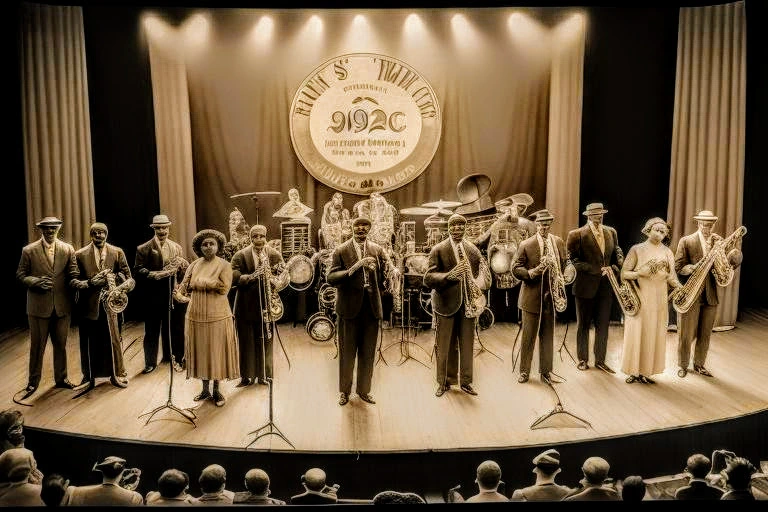Final Grade: C
It did the job, but as always, I expected more creativity and diversity from the AI. As for the video, I used https://app.runwayml.com, a free AI-Gen web app that animates stills, but only in four-second durations, hence all the clips edited together. I reversed every other shot in hopes to create a somewhat natural looking pan left/right sequence, but it did not exactly work out as I had hoped. After eight generations of the same stem, I took the resulting 32-second clip and like before, repeated it, reversing every other, and fading the “tails” into the “heads,” but you get what you pay for. The sepia tone of the original still was fluctuating, so I knocked the video clips down to grey-scale. It’s better than staring at a still for three minutes, and I am still new to AI-Gen video, and know there are better tools available, but I am exploring for now. Stay tuned…
StableAudio.com Text Prompt: 1920s Americana: African American Spiritual song and instrumentation
Downloads
- Video
- Audio
We are embarking on a sub-series of our AI-Gen Americana project: The History of Americana. As TATANKA will play selections from the 1920s through the 2020s, this effort will help further illustrate the TATANKA sound and repertoire. We begin with an overall history of the Americana genre, followed by specific decades, article by article. So, sit up straight, slap on those headphones, and get ready for some serious, in-depth Americana education!
History of Americana Music 1920s – 2020s

Americana music has a rich history that dates back to the early 1920s, when it emerged as a uniquely American genre that blended elements of folk, country, blues, and rock music. The roots of Americana music can be traced back to the rural cultures of the American South, where musicians would gather on front porches and at country fairs to play traditional folk songs and ballads. The genre gained popularity in the 1920s with the advent of radio and the recording industry, which helped to spread the music to a wider audience.
One of the defining characteristics of Americana music is its focus on storytelling and narrative songwriting. Artists in the genre often draw on themes of love, loss, and the American experience in their songwriting, creating a rich tapestry of songs that reflect the diversity of the American landscape. The music is also known for its stripped-down, acoustic sound, which harkens back to the roots of folk and country music.
In the 1930s and 1940s, Americana music continued to evolve as artists began to incorporate elements of blues and rock into their sound. This period saw the rise of artists such as Woody Guthrie, Lead Belly, and Hank Williams, who helped to popularize the genre and bring it to a wider audience. The music of this era reflected the social and political turmoil of the time, with many artists using their music to protest war, poverty, and injustice.
The 1950s and 1960s saw Americana music continue to evolve, with artists like Bob Dylan, Johnny Cash, and The Byrds blending elements of folk, country, and rock into their sound. This period also saw the emergence of the folk revival movement, which brought traditional American folk music back into the mainstream. Artists like Joan Baez, Pete Seeger, and The Kingston Trio helped to popularize folk music and bring it to a new generation of listeners.
The 1970s and 1980s saw a resurgence of interest in Americana music, with artists like Emmylou Harris, The Band, and Neil Young blending elements of folk, country, and rock into their sound. This period also saw the rise of alternative country and roots rock bands like Uncle Tupelo and The Jayhawks, who helped to bring a new energy and vitality to the genre. Americana music continued to evolve in the 1990s, with artists like Gillian Welch, Ryan Adams, and Lucinda Williams pushing the boundaries of the genre and exploring new musical territory.
In the 2000s and 2010s, Americana music continued to thrive, with artists like Amanda Shires, The Avett Brothers, and Sturgill Simpson gaining critical acclaim and commercial success. This period also saw the rise of Americana festivals and radio stations, which helped to promote the genre and bring it to a wider audience. Americana music has continued to evolve in the 2020s, with artists like Brandi Carlile, Tyler Childers, and Sarah Jarosz pushing the boundaries of the genre and exploring new musical territory.
In conclusion, Americana music has a rich and storied history that spans nearly a century. From its roots in the rural cultures of the American South to its modern incarnation as a vibrant and dynamic genre, Americana music has always been at the forefront of American musical innovation. With its focus on storytelling, narrative songwriting, and diverse musical influences, Americana music continues to captivate audiences and inspire artists to push the boundaries of the genre. As we look to the future, it is clear that Americana music will continue to evolve and thrive, drawing on the rich tapestry of American musical traditions to create a sound that is uniquely American.
1920s Americana Music
In the 1920s, Americana music emerged as a prominent genre reflecting the cultural and societal changes happening in the United States during that time. This era saw the rise of new musical styles such as jazz, blues, country, and folk music, all of which played a significant role in shaping the American music landscape. The 1920s were a period of great economic prosperity known as the “Roaring Twenties,” and this prosperity contributed to the growth and popularity of Americana music.
One of the defining characteristics of 1920s Americana music was its diverse influences and blending of musical traditions. African American musicians played a central role in shaping the music of the era, particularly in the development of jazz and blues. Artists such as Louis Armstrong, Bessie Smith, and Duke Ellington achieved fame and recognition for their innovative music that combined elements of African American spirituals, blues, and ragtime.
The rise of radio broadcasting and the recording industry in the 1920s also played a crucial role in the popularization of Americana music. This era saw the advent of commercial radio stations that broadcast music to a wide audience, allowing musicians to reach a larger audience than ever before. Furthermore, the invention of the phonograph and the rise of record labels like Columbia and RCA Victor made it possible for musicians to record and distribute their music on a mass scale.
Country music also experienced significant growth and popularity in the 1920s, with artists like the Carter Family and Jimmie Rodgers paving the way for the genre’s future success. Country music drew inspiration from folk, blues, and gospel music, creating a unique sound that resonated with audiences across the country. The Carter Family, in particular, played a pivotal role in popularizing country music through their recordings and radio performances.
Folk music also flourished in the 1920s, with artists like Woody Guthrie and Lead Belly gaining recognition for their authentic and heartfelt music. Guthrie, in particular, used his music to address social and political issues of the time, such as the Great Depression and labor struggles. His songs, such as “This Land Is Your Land,” are now considered classics of Americana music and continue to be beloved by audiences around the world.
The 1920s also saw the emergence of influential female musicians in Americana music, breaking stereotypes and paving the way for future generations of female artists. Bessie Smith, often referred to as the “Empress of the Blues,” captivated audiences with her powerful vocals and emotional delivery. Similarly, country music pioneer Maybelle Carter of the Carter Family showcased her exceptional guitar playing and songwriting skills, influencing countless musicians in the years to come.
The Great Depression of the 1930s brought about significant challenges for Americana music, as economic hardships forced many artists to struggle to make a living. However, the resilience and creativity of musicians during the 1920s allowed Americana music to continue to thrive and evolve. Artists like Billie Holiday and Hank Williams continued to push boundaries and create groundbreaking music that resonated with listeners across the country.
1920s Americana music was a vibrant and dynamic period in American musical history, characterized by innovation, diversity, and cultural significance. The era saw the rise of new musical styles like jazz, blues, country, and folk, all of which played a crucial role in shaping the American music landscape. The influence of African American musicians, the growth of radio broadcasting and the recording industry, and the emergence of influential female artists all contributed to the success and popularity of Americana music in the 1920s. Despite the challenges posed by the Great Depression, Americana music continued to evolve and thrive, leaving a lasting legacy that continues to influence artists and audiences to this day.
Free Verse text prompt (https://poemgenerator.io):
1920s African American Spiritual Music and Experience
In the 1920s, a rhythm was born
A heartbeat of resilience and grace
Echoing through the cotton fields
And the crowded city streetsThe voices of the oppressed
Rising up in harmony
Singing songs of freedom
And redemption in the face of adversityThe spirituals, a sacred gift
Passed down through generations
A language of the soul
Speaking truths that words could not conveyIn the depths of despair
And the heights of joy
These songs were a beacon
Guiding the way to a brighter tomorrowThrough the pain of segregation
And the trials of discrimination
The music was a refuge
A source of strength and solaceThe power of the spirituals
Transcended time and space
Uniting hearts and minds
In a shared experience of hope and healingSo let us honor those who came before
poemgenerator.io
And carry on their legacy
In our voices and our hearts
Forever singing the songs of freedom and faith
Sound Effects
- Crowd Background Noise Sound Effect from Pixabay
- Crowd Applauding Sound Effect by Gregor Quendel from Pixabay
